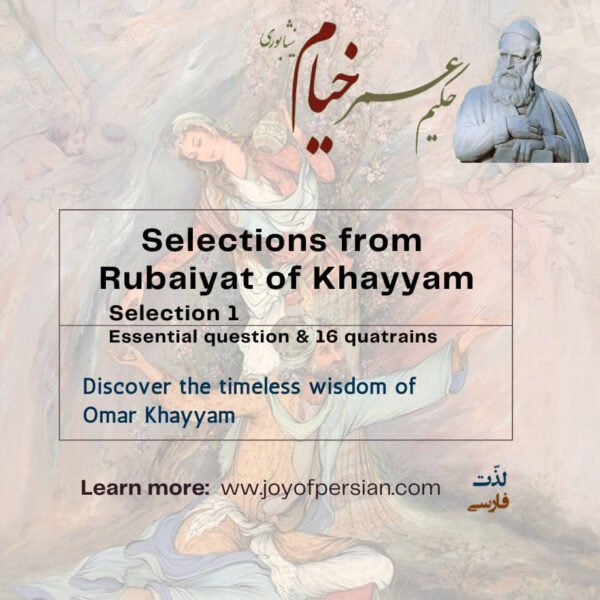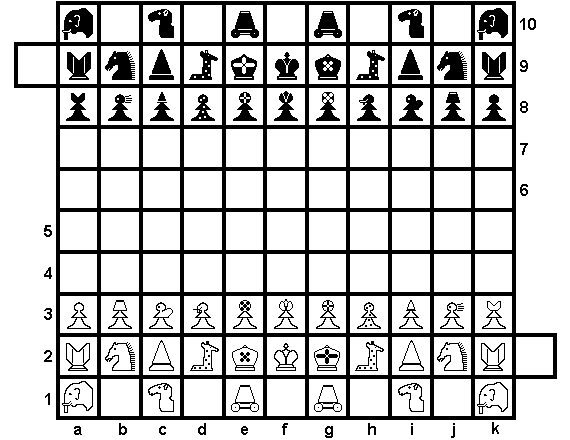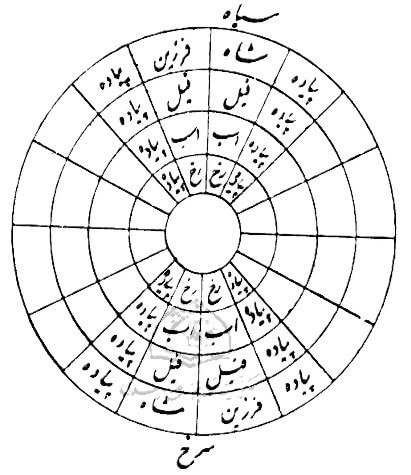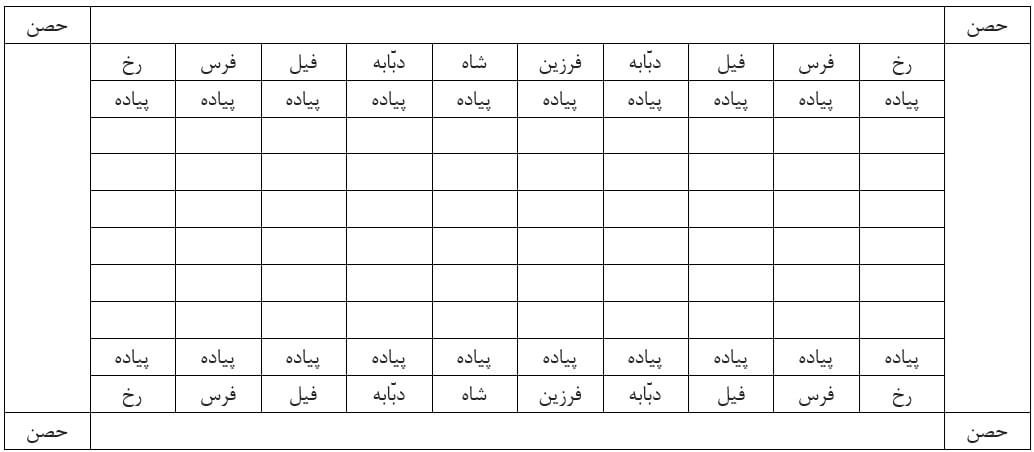Chess is one of the oldest and most revered games in human history. With its deep strategic complexity and rich historical background, chess has captured the imagination of countless cultures, none more so than Persia. Persia, the historical region roughly corresponding to modern-day Iran, played a crucial role in the development, spread, and cultural significance of chess. From its origins in India to its flourishing in Persian courts, chess became more than just a game; it became a symbol of wisdom, strategy, and power. This article explores the intricate history of chess in Persia, how it influenced Persian culture, and how its legacy continues to thrive.
- Origins of Chess: India and its Journey to Persia
- Chess in Sasanian Persia
- Ferdowsi’s Shahnameh and the Myth of Chess
- The Spread of Chess in the Islamic World
- Chess in Persian Literature
- ♟️🎲 Go Deeper with Khayyam's Rubaiyat
- Persian Chess Terms and Their Influence
- Chess and Persian Art
- Chess Variants in Medieval Persia
- Chess in Modern Iran
- Conclusion
Origins of Chess: India and its Journey to Persia
The exact origins of chess are shrouded in mystery, but the consensus among historians is that chess has its roots in India. The ancient Indian game chaturanga, which dates back to at least the 6th century CE, is widely considered the earliest known form of chess. Chaturanga was a game that reflected the fourfold division of the Indian army—infantry, cavalry, elephants, and chariots—each represented by pieces on the board. This Indian game slowly evolved into what we recognize as modern chess today, and it began its journey westward toward Persia around the 7th century CE.
When chaturanga reached Persia, it was transformed into shatranj. This version of the game closely resembled modern chess, though with some differences in the movement of certain pieces. The introduction of shatranj to Persia marked the beginning of a long and rich relationship between Persia and chess, one that would have lasting impacts on both the game and Persian culture.
Chess in Sasanian Persia
Persia was already a powerful and influential empire by the time chess arrived. The Sasanian Empire (224–651 CE) was one of the last great empires of ancient Persia, and its court was a center of art, science, and learning. It was during this period that chess became a prominent fixture in Persian royal and noble circles.
One of the earliest mentions of chess in Persian literature appears in the Pahlavi text Karnamak-i Ardashir-i Papakan (The Book of the Deeds of Ardashir), which recounts the deeds of Ardashir I, the founder of the Sasanian Empire. In the story, Ardashir is described as a wise and strategic ruler, and his skill at chess is highlighted as one of his virtues. This early reference shows how closely chess was associated with intellectual prowess and leadership in Persia.
Another notable reference comes from the 6th-century work Khosrow and His Page (Xusrau u rētak), where chess is mentioned alongside other games like backgammon. The game’s association with the Persian nobility is further reinforced by the story of Bozorgmehr, the famous vizier of Khosrow I. Bozorgmehr is credited with solving the riddle of chess, which was supposedly sent to the Persian court by an Indian king. In return, Bozorgmehr created the game of backgammon as a counter-challenge. This story, although largely mythical, highlights the importance of chess in Persian royal culture and the game’s role as a symbol of intellect and strategy.
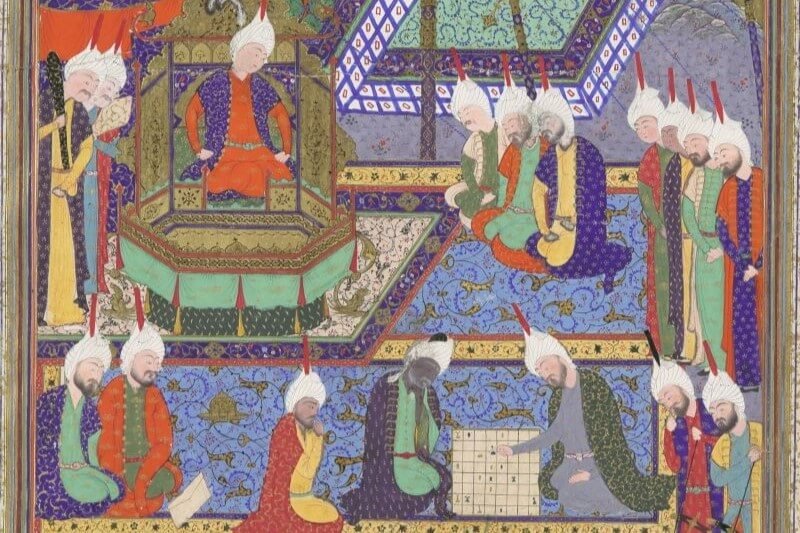
Ferdowsi’s Shahnameh and the Myth of Chess
Perhaps the most famous account of the introduction of chess to Persia comes from Ferdowsi’s Shahnameh (The Book of Kings), an epic poem written around the year 1000 CE. The Shahnameh is one of the most important works of Persian literature, and it recounts the history of the Persian kings from mythical times to the fall of the Sasanian Empire.
In one of the stories in the Shahnameh, chess is said to have been brought to Persia from India during the reign of Khosrow Anushirvan. The Indian king sent the game as a challenge, asking the Persians to decipher its rules. Khosrow’s vizier, Bozorgmehr, successfully figured out the game and became renowned for his wisdom and intelligence.
In Persian:
| چنین گفت موبد که یک روز شاه | به دیبای رومی بیاراست گاه |
| بیاویخت تاج از بر تخت عاج | همه جای عاج و همه جای تاج |
| همه کاخ پر موبد و مرزبان | ز بلخ و ز بامین و ز کرزبان |
| چنین آگهی یافت شاه جهان | ز گفتار بیدار کارآگهان |
| که آمد فرستادهٔ شاه هند | ابا پیل و چتر و سواران سند |
| شتروار بارست با او هزار | همی راه جوید بر شهریار |
| همانگه چو بشنید بیدار شاه | پذیره فرستاد چندی سپاه |
| چو آمد بر شهریار بزرگ | فرستادهٔ نامدار و سترگ |
| برسم بزرگان نیایش گرفت | جهان آفرین را ستایش گرفت |
| گهرکرد بسیار پیشش نثار | یکی چتر و ده پیل با گوشوار |
| بیاراسته چتر هندی به زر | بدو بافته چند گونه گهر |
| سر بار بگشاد در بارگاه | بیاورد یک سر همه نزد شاه |
| فراوان ببار اندرون سیم و زر | چه از مشک و عنبر چه از عود تر |
| ز یاقوت والماس وز تیغ هند | همه تیغ هندی سراسر پرند |
| ز چیزی که خیزد ز قنوج و رای | زده دست و پای آوریده به جای |
| ببردند یک سر همه پیش تخت | نگه کرد سالار خورشید بخت |
| ز چیزی که برد اندران رای رنج | فرستاد کسری سراسر به گنج |
| بیاورد پس نامهای بر پرند | نبشته بنوشینروان رای هند |
| یکی تخت شطرنج کرده به رنج | تهی کرده از رنج شطرنج گنج |
| بیاورد پیغام هندی ز رای | که تا چرخ باشد تو بادی به جای |
| کسی کو بدانش برد رنج بیش | بفرمای تا تخت شطرنج پیش |
| نهند و ز هر گونه رای آورند | که این نغز بازی به جای آورند |
| بدانند هرمهرهای را به نام | که گویند پس خانهٔ او کدام |
| پیاده بدانند و پیل و سپاه | رخ واسب و رفتار فرزین و شاه |
| گراین نغز بازی به جای آورند | درین کار پاکیزه رای آورند |
| همان باژ و ساوی که فرمودشاه | به خوبی فرستم بران بارگاه |
| وگر نامداران ایران گروه | ازین دانش آیند یک سر ستوه |
| چو با دانش ما ندارند تاو | نخواهند زین بوم و بر باژ و ساو |
| همان باژ باید پذیرفت نیز | که دانش به از نامبردار چیز |
| دل و گوش کسری بگوینده داد | سخنها برو کرد گوینده یاد |
| نهادند شطرنج نزدیک شاه | به مهره درون کرد چندی نگاه |
| ز تختش یکی مهره از عاج بود | پر از رنگ پیکر دگر ساج بود |
| بپرسید ازو شاه پیروزبخت | ازان پیکر ومهره ومشک وتخت |
| چنین داد پاسخ که ای شهریار | همه رسم و راه از در کارزار |
| ببینی چویابی به بازیش راه | رخ و پیل و آرایش رزمگاه |
| بدو گفت یک هفته ما را زمان | ببازیم هشتم به روشنروان |
| یکی خرم ایوان بپرداختند | فرستاده را پایگه ساختند |
| رد وموبدان نماینده راه | برفتند یک سر به نزدیک شاه |
| نهادند پس تخت شطرنج پیش | نگه کرد هریک ز اندازه بیش |
| بجستند و هر گونهای ساختند | ز هر دست یکبارش انداختند |
| یکی گفت وپرسید و دیگر شنید | نیاورد کس راه بازی پدید |
| برفتند یکسر پرآژنگ چهر | بیامد برشاه بوزرجمهر |
| ورا زان سخن نیک ناکام دید | به آغاز آن رنج فرجام دید |
| به کسری چنین گفت کای پادشا | جهاندار و بیدار و فرمانروا |
| من این نغز بازی به جای آورم | خرد را بدین رهنمای آورم |
| بدو گفت شاه این سخن کارتست | که روشنروان بادی وتندرست |
| کنون رای قنوج گوید که شاه | ندارد یکی مرد جوینده راه |
| شکست بزرگ است بر موبدان | به در گاه و بر گاه و بر بخردان |
| بیاورد شطرنج بوزرجمهر | پراندیشه بنشست و بگشاد چهر |
| همیجست بازی چپ و دست راست | همیراند تا جای هریک کجاست |
| به یک روز و یک شب چو بازیش یافت | از ایوان سوی شاه ایران شتافت |
| بدو گفت کای شاه پیروزبخت | نگه کردم این مهره و مشک و تخت |
| به خوبی همه بازی آمد به جای | به بخت بلند جهان کدخدای |
| فرستادهٔ شاه را پیش خواه | کسی را که دارند ما را نگاه |
| شهنشاه باید که بیند نخست | یکی رزمگاهست گویی درست |
| ز گفتار او شاد شد شهریار | ورا نیک پی خواند و به روزگار |
| بفرمود تا موبدان و ردان | برفتند با نامور بخردان |
| فرستاده رای را پیش خواند | بران نامور پیشگاهش نشاند |
| بدو گفت گوینده بوزرجمهر | که ای موبد رای خورشید چهر |
| ازین مهرها رای با توچه گفت | که همواره با توخرد باد جفت |
| چنین داد پاسخ که فرخندهرای | چو از پیش او من برفتم ز جای |
| مرا گفت کین مهرهٔ ساج و عاج | ببر پیش تخت خداوند تاج |
| بگویش که با موبد و رایزن | بنه پیش و بنشان یکی انجمن |
| گر این نغز بازی به جای آورند | پسندیده و دلربای آورند |
| همین بدره و برده و باژ و ساو | فرستیم چندانک داریم تاو |
| و گر شاه و فرزانگان این به جای | نیارند روشن ندارند رای |
| وگر شاه وفرزانگان این بجای | نیارند روشن ندارند رای |
| نباید که خواهد ز ما باژ و گنج | دریغ آیدش جان دانا به رنج |
| چو بیند دل و رای باریک ما | فزونتر فرستد به نزدیک ما |
| برتخت آن شاه بیداربخت | بیاورد و بنهاد شطرنج وتخت |
| چنین گفت با موبدان و ردان | کهای نامور پاک دل بخردان |
| همه گوش دارید گفتار اوی | هم آن را هشیار سالار اوی |
| بیاراست دانا یکی رزمگاه | به قلب اندرون ساخته جای شاه |
| چپ و راست صف برکشیده سوار | پیاده به پیش اندرون نیزه دار |
| هشیوار دستور در پیش شاه | به رزم اندرونش نماینده راه |
| مبارز که اسب افگند بر دو روی | به دست چپش پیل پرخاشجوی |
| وزو برتر اسبان جنگی به پای | بدان تاکه آید به بالای رای |
| چو بوزرجمهر آن سپه را براند | همه انجمن درشگفتی بماند |
| غمی شد فرستادهٔ هند سخت | بماند اندر آن کار هشیار بخت |
| شگفت اندرو مرد جادو بماند | دلش را به اندیشه اندر نشاند |
| که این تخت شطرنج هرگز ندید | نه از کاردانان هندی شنید |
| چگونه فراز آمدش رای این | به گیتی نگیرد کسی جای این |
| چنان گشت کسری ز بوزرجمهر | که گفتی بدوبخت بنمود چهر |
| یکی جام فرمود پس شهریار | که کردند پرگوهر شاهوار |
| یکی بدره دینار واسبی به زین | بدو داد و کردش بسی آفرین |
| بشد مرد دانا به آرام خویش | یکی تخت و پرگار بنهاد پیش |
| به شطرنج و اندیشهٔ هندوان | نگه کرد و بفزود رنج روان |
| خرد بادل روشن انباز کرد | به اندیشه بنهاد برتخت نرد |
| دومهره بفرمود کردن ز عاج | همه پیکر عاج همرنگ ساج |
| یکی رزمگه ساخت شطرنج وار | دو رویه برآراسته کارزار |
| دولشکر ببخشید بر هشت بهر | همه رزمجویان گیرنده شهر |
| زمین وار لشکر گهی چارسوی | دوشاه گرانمایه و نیک خوی |
| کم و بیش دارند هر دو به هم | یکی از دگر برنگیرد ستم |
| به فرمان ایشان سپاه از دو روی | به تندی بیاراسته جنگجوی |
| یکی را چوتنها بگیرد دو تن | ز لشکر برین یک تن آید شکن |
| به هرجای پیش وپس اندر سپاه | گرازان دو شاه اندران رزمگاه |
| همی این بران آن برین برگذشت | گهی رزم کوه و گهی رزم دشت |
| برین گونه تا بر که بودی شکن | شدندی دو شاه و سپاه انجمن |
| بدین سان که گفتم بیاراست نرد | برشاه شد یک به یک یاد کرد |
| وزان رفتن شاه برترمنش | همانش ستایش همان سرزنش |
| ز نیروی و فرمان و جنگ سپاه | بگسترد و بنمود یک یک شاه |
| دل شاه ایران ازو خیره ماند | خرد را باندیشه اندر نشاند |
| همیگفت کای مرد روشنروان | جوان بادی و روزگارت جوان |
| بفرمود تا ساروان دو هزار | بیارد شتر تا در شهریار |
| ز باری که خیزد ز روم و ز چین | ز هیتال و مکران و ایران زمین |
| ز گنج شهنشاه کردند بار | بشد کاروان از در شهریار |
| چوشد بارهای شتر ساخته | دل شاه زان کار پرداخته |
| فرستادهٔ رای را پیش خواند | ز دانش فراوان سخنها براند |
| یکی نامه بنوشت نزدیک اوی | پر از دانش و رامش و رنگ و بوی |
| سر نامه کرد آفرین بزرگ | به یزدان پناهش ز دیو سترگ |
| دگر گفت کای نامور شاه هند | ز دریای قنوج تا پیش سند |
| رسیداین فرستادهٔ رایزن | ابا چتر و پیلان بدین انجمن |
| همان تخت شطرنج و پیغام رای | شنیدیم و پیغامش امد بجای |
| ز دانای هندی زمان خواستیم | به دانش روان را بیاراستیم |
| بسی رای زد موبد پاکرای | پژوهید وآورد بازی به جای |
| کنون آمد این موبد هوشمند | به قنوج نزدیک رای بلند |
| شتروار بار گران دو هزار | پسندیده بار از در شهریار |
| نهادیم برجای شطرنج نرد | کنون تا به بازی که آرد نبرد |
| برهمن فراوان بود پاکرای | که این بازی آرد به دانش به جای |
| ز چیزی که دید این فرستاده رنج | فرستد همه رای هندی به گنج |
| ور ایدون کجا رای با راهنمای | بکوشند بازی نیاید به جای |
| شتروار باید که هم زین شمار | به پیمان کند رای قنوج بار |
| کند بار همراه با بار ما | چنینست پیمان و بازار ما |
| چوخورشید رخشنده شد بر سپهر | برفت از در شاه بوزرجمهر |
| چو آمد ز ایران به نزدیک رای | برهمن بشادی ورا رهنمای |
| ابا بار با نامه وتخت نرد | دلش پر ز بازار ننگ ونبرد |
| چو آمد به نزدیکی تخت اوی | بدید آن سر و افسر و بخت اوی |
| فراوانش بستود بر پهلوی | بدو داد پس نامهٔ خسروی |
| ز شطرنج وز راه وز رنج رای | بگفت آنچه آمد یکایک به جای |
| پیام شهنشاه با او بگفت | رخ رای هندی چوگل برشگفت |
| بگفت آن کجا دید پاینده مرد | چنان هم سراسر بیاورد نرد |
| ز بازی و از مهره و رای شاه | وزان موبدان نماینده راه |
| به نامه دورن آنچه کردست یاد | بخواند بداند نپیچد ز داد |
| ز گفتار اوشد رخ شاه زرد | چو بشنید گفتار شطرنج و نرد |
| بیامد یکی نامور کدخدای | فرستاده را داد شایستهجای |
| یکی خرم ایوان بیاراستند | می و رود و رامشگران خواستند |
| زمان خواست پس نامور هفت روز | برفت آنک بودند دانش فروز |
| به کشور ز پیران شایسته مرد | یکی انجمن کرد و بنهاد نرد |
| به یک هفته آنکس که بد تیزویر | ازان نامداران برنا و پیر |
| همیبازجستند بازی نرد | به رشک و برای وبه ننگ و نبرد |
| بهشتم چنین گفت موبد به رای | که این را نداند کسی سر زپای |
| مگر با روان یار گردد خرد | کزین مهره بازی برون آورد |
| بیامد نهم روز بوزرجمهر | پر از آرزو دل پرآژنگ چهر |
| که کسری نفرمود ما را درنگ | نباید که گردد دل شاه تنگ |
| بشد موبدان را ازان دل دژم | روان پر زغم ابروان پر زخم |
| بزرگان دانا به یک سو شدند | به نادانی خویش خستو شدند |
| چو آن دید بنشست بوزرجمهر | همه موبدان برگشادند چهر |
| بگسترد پیش اندرون تخت نرد | همه گردش مهرها یاد کرد |
| سپهدار بنمود و جنگ سپاه | هم آرایش رزم و فرمان شاه |
| ازو خیره شد رای با رایزن | ز کشور بسی نامدار انجمن |
| همه مهتران آفرین خواندند | ورا موبد پاک دین خواندند |
| ز هر دانشی زو بپرسید رای | همه پاسخ آمد یکایک به جای |
| خروشی برآمد ز دانندگان | ز دانش پژوهان وخوانندگان |
| که اینت سخنگوی داننده مرد | نه از بهر شطرنج و بازی نرد |
| بیاورد زان پس شتر دو هزار | همه گنج قنوح کردند بار |
| ز عود و ز عنبر ز کافور و زر | همه جامه وجام پیکر گهر |
| ابا باژ یکساله از پیشگاه | فرستاد یک سر به درگاه شاه |
| یکی افسری خواست از گنج رای | همان جامهٔ زر ز سر تا به پای |
| بدو داد وچند آفرین کرد نیز | بیارانش بخشید بسیار چیز |
| شتر دو هزار آنک از پیش برد | ابا باژ و هدیه مر او را سپرد |
| یکی کاروان بد که کس پیش ازان | نراند و نبد خواسته بیش ازان |
| بیامد ز قنوج بوزرجمهر | برافراخته سر بگردان سپهر |
| دلی شاد با نامه شاه هند | نبشته به هندی خطی بر پرند |
| که رای و بزرگان گوایی دهند | نه از بیم کزنیک رایی دهند |
| که چون شاه نوشینروان کس ندید | نه از موبد سالخورده شنید |
| نه کس دانشی تر ز دستور اوی | ز دانش سپهرست گنجور اوی |
| فرستاده شد باژ یک ساله پیش | اگر بیش باید فرستیم بیش |
| ز باژی که پیمان نهادیم نیز | فرستاده شد هرچ بایست چیز |
| چو آگاهی آمد ز دانا به شاه | که با کام و با خوبی آمد ز راه |
| ازان آگهی شاد شد شهریار | بفرمود تاهرک بد نامدار |
| ز شهر و ز لشکر خبیره شدند | همه نامداران پذیره شدند |
| به شهر اندر آمد چنان ارجمند | به پیروزی شهریار بلند |
| به ایوان چو آمد به نزدیک تخت | برو شهریار آفرین کرد سخت |
| ببر در گرفتش جهاندار شاه | بپرسیدش از رای وز رنج راه |
| بگفت آنکجا رفت بوزرجمهر | ازان بخت بیدار و مهر سپهر |
| پس آن نامه رای پیروزبخت | بیاورد و بنهاد در پیش تخت |
| بفرمود تا یزدگرد دبیر | بیامد بر شاه دانشپذیر |
| چو آن نامه رای هندی بخواند | یکی انجمن درشگفتی بماند |
| هم از دانش و رای بوزرجمهر | ازان بخت سالار خورشید چهر |
| چنین گفت کسری که یزدان سپاس | که هستم خردمند و نیکیشناس |
| مهان تاج وتخت مرا بندهاند | دل وجان به مهر من آگندهاند |
| شگفتیتر از کار بوزرجمهر | که دانش بدو داد چندین سپهر |
| سپاس از خداوند خورشید وماه | کزویست پیروزی و دستگاه |
| برین داستان برسخن ساختم | به طلخند و شطرنج پرداختم |
Later, Ferdowsi expands on the Indian origin of chess, telling the story of two brothers, Gav and Ṭalḵand, who fought for the throne of India. After Ṭalḵand mysteriously died in battle, his brother invented the game of chess to convey the news of his death to their mother in a symbolic way.
This story, filled with legend, is an important part of Persian cultural memory, showcasing how the game of chess was intertwined with the themes of strategy, intelligence, and fate.
The Spread of Chess in the Islamic World
After the fall of the Sasanian Empire in 651 CE, Persia became part of the Islamic Caliphate. However, Persian culture continued to flourish under Islamic rule, and chess remained an important part of courtly life. The game spread throughout the Islamic world, from the Middle East to North Africa and Spain, largely due to the influence of Persian culture and scholars.
One of the most important figures in the early history of Islamic chess was the Turkish scholar Al-Suli (880–946 CE). Al-Suli was a renowned chess player and wrote one of the earliest known books on chess strategy, Kitab ash-Shatranj (The Book of Chess). His work was highly influential and helped to codify many of the strategies and principles of chess that are still used today.
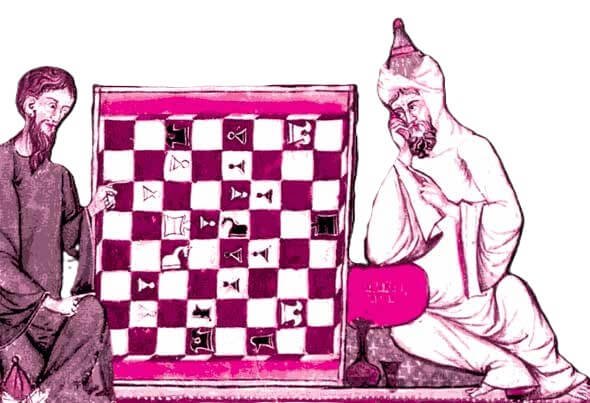
Chess in Persian Literature
Chess also became a common subject in Islamic art and literature. Persian poets often used chess as a metaphor for the complexities of life, politics, and fate. We previously examined how chess is featured in the Shahnameh. Now, let’s explore other direct references to chess in Persian literature:
Rumi:
| برد و ماندی هست آخر تا کی ماند کی برد | ور نه این شطرنج عالم چیست با جنگ و جهاد |
| گه ره شه را بگیرد بیدق کژرو به ظلم | چیست فرزین گشتهام گر کژ روم باشد سداد |
| من پیاده رفتهام در راستی تا منتها | تا شدم فرزین و فرزین بندهاام دست داد |
| رخ بدو گوید که منزلهات ما را منزلیست | خط و تین ماست این جمله منازل تا معاد |
| تن به صد منزل رود دل میرود یک تک به حج | ره روی باشد چو جسم و ره روی همچون فؤاد |
| شاه گوید مر شما را از منست این یاد و بود | گر نباشد سایه من بود جمله گشت باد |
| اسب را قیمت نماند پیل چون پشه شود | خانهها ویرانهها گردد چو شهر قوم عاد |
| اندر این شطرنج برد و ماند یک سان شد مرا | تا بدیدم کاین هزاران لعب یک کس مینهاد |
| در نجاتش مات هست و هست در ماتش نجات | زان نظر ماتیم ای شه آن نظر بر مات باد |
Also by Rumi:
حکایت مات کردن دلقک سید شاه ترمذ را
| شاه با دلقک همی شطرنج باخت | مات کردش زود خشم شه بتاخت |
| گفت شه شه و آن شه کبرآورش | یک یک از شطرنج میزد بر سرش |
| که بگیر اینک شهت ای قلتبان | صبر کرد آن دلقک و گفت الامان |
| دست دیگر باختن فرمود میر | او چنان لرزان که عور از زمهریر |
| باخت دست دیگر و شه مات شد | وقت شه شه گفتن و میقات شد |
| بر جهید آن دلقک و در کنج رفت | شش نمد بر خود فکند از بیم تفت |
| زیر بالشها و زیر شش نمد | خفت پنهان تا ز زخم شه رهد |
| گفت شه هی هی چه کردی چیست این | گفت شه شه شه شه ای شاه گزین |
| کی توان حق گفت جز زیر لحاف | با تو ای خشمآور آتشسجاف |
“The King of Termed and the Jester”
Once upon a time, the King of Termez played chess with the court jester. The jester quickly checkmated the king and repeatedly called out, “Check! Check!” When the king realized he was trapped and had no choice but to be checkmated, he became furious. In a fit of rage, he smashed the chess pieces on the jester’s head, insulted him, and then gave him a severe beating.
Wanting to avenge his defeat, the king challenged the jester to another game. Fearing the consequences of checkmating the king again, the jester began the game timidly and, as luck would have it, checkmated the king once more. Immediately, he jumped up and hid under a pile of felt. The king, unaware of his own defeat, was puzzled and asked, “Hey jester! Why did you leave the game halfway? Where did you go? What are you doing?” From under the felt, the jester replied, “Your Majesty, you’ve been checkmated again. I’m ready for my beating now.”
Mohtasham Kashani
| با تو آن روز که شطرنج محبت چیدم | ماتی خود ز تو در بازی اول دیدم |
| هوسم رخ به رخ شاه خیال تو نشاند | آن قدر کز رخ شرم تو خجل گردیدم |
| اسب جرات چو هوس تاخت به جولانگه عشق | من رخ از عرصهٔ راحت طلبی تابیدم |
| استخوانبندی شطرنج جهان کی شده بود | صبح ابداع که من مهر تو میورزیدم |
| هجر چون اسب حریفان مسافر زین کرد | عرصه خالی شد از آشوب و من آرامیدم |
| آن دلارام که منصوبه طرازی فن اوست | بیدقی راند که صد بازی از آن فهمیدم |
| فکر خود کن تو هم ای دل که به تاراج بساط | شاه عشق آمد و من خانهٔ خود برچیدم |
| محتشم از تو و از قدر تو افسوس که من | پشه و پیل درین عرصه برابر دیدم |
Saadi
Golestan of Saadi, Chapter 7, Story 12
سالی نزاعی در پیادگان حجیج افتاده بود و داعی در آن سفر هم پیاده. انصاف در سر و روی هم فتادیم و داد فسوق و جدال بدادیم.
کجاوهنشینی را شنیدم که با عدیل خود میگفت: یاللعجب! پیادهٔ عاج چو عرصه شطرنج به سر میبرد فرزین میشود، یعنی به از آن میگردد که بود و پیادگان حاج بادیه به سر بردند و بتر شدند.
| از من بگوی حاجی مردم گزای را | کاو پوستین خلق به آزار میدرد |
| حاجی تو نیستی شتر است از برای آنک | بیچاره خار میخورد و بار میبرد |
Chess has also been considered a means of getting rid of boredom:
| نظر کردم به چشم رای و تدبیر | ندیدم بِه زِ خاموشی، خِصالی |
| نگویم لَب ببند و دیده بَردوز | ولیکن، هر مقامی را مَقالی |
| زمانی، درسِ عِلم و بحثِ تَنزیل | که باشد نَفْسِ انسان را کمالی |
| زمانی، شعر و شطرنج و حکایت | که خاطر را بُوَد دَفعِ مَلالی |
| خدای است آنکه ذاتِ بینظیرش | نگردد هرگز از حالی به حالی |
Khayyam
Omar Khayyam’s Rubaiyat subtly likens life to a game controlled by an unseen hand, reflecting on the transience of human existence and the inevitability of fate.
| ما لُعْبَتِکانیم و فلک لُعبَتباز، | از روی حقیقتی نه از روی مَجاز؛ |
| یکچند درین بساط بازی کردیم، | رفتیم به صندوقِ عدم یکیک باز! |
صادق هدایت:
یک بازیگرخانهٔ غریبی است. مثل خیمهشببازی یا بازی شطرنج، همهٔ کاینات روی صفحه گمان میکنند که آزادند. ولی یک دست نامرئی که متعلق به یک ابله یا بچه است مدتی با ما تفریح میکند. ما را جابهجا میکند، بعد دلش را میزند، دوباره این عروسکها یا مهرهها را در صندوق فراموشی و نیستی میاندازد:
We are but chessmen, who to move are fain,
Just as the great Chessplayer doth ordain.
It moves us on life’s chess-board to and fro,
And then in death’s box shuts us up again.
[tr. Whinfield (1882), # 148]
This poetic imagery captures the way chess was viewed in Persian culture—not just as a game, but as a symbol of the human condition.
♟️🎲 Go Deeper with Khayyam’s Rubaiyat
Enjoyed this exploration of chess’s role in Persian culture and literature? Many metaphors, like those equating life to a chess game controlled by fate, come directly from poetic masterpieces such as Omar Khayyam’s quatrains.
We invite you to explore the original source in our course: “Selections from the Rubaiyat of Khayyam”.
You can access the first lesson right now — no sign-up required!
🎁 Special Gift for Our Readers:
Enjoy 50% off with the code IQMATMWD — available for the first 11 users only, and it even stacks with other ongoing offers!
Persian Chess Terms and Their Influence
Many of the terms used in modern chess have Persian origins. The most famous example is the term “checkmate,” which comes from the Persian phrase shah mat, meaning “the king is helpless” or “the king is dead.” This phrase reflects the central goal of the game—to trap the opposing king in a position from which he cannot escape.
Other chess terms that have Persian roots include:
- Rook: Derived from the Persian word rokh, meaning “chariot” or “warrior.”
- Bishop: In Persian fil, meaning “elephant,” a reflection of the Indian origins of the game where elephants played a key role in chaturanga.
- Queen: Known in Persian as farzin or vizier, symbolizing the royal advisor, who had significant power on the board.
These Persian terms were carried over into Arabic and eventually into European languages as chess spread westward. The game underwent some changes along the way, including modifications to the movement of certain pieces, but the core structure and terminology remained heavily influenced by Persian chess.
Chess and Persian Art
In addition to its literary and linguistic influence, chess also became a popular subject in Persian art. Miniature paintings, a key art form in Persia, often depicted scenes of royal courts where chess was being played. These paintings were highly detailed and symbolic, often using the game as a metaphor for political and military strategy.
One famous example of chess in Persian art is the depiction of the court of Khosrow Anushirvan, where the game of chess is shown as a key element of courtly life. The figures in these paintings are often depicted in a highly stylized manner, with elaborate clothing and settings, reflecting the grandeur of the Persian court and the importance of chess as a symbol of royal wisdom and strategy.
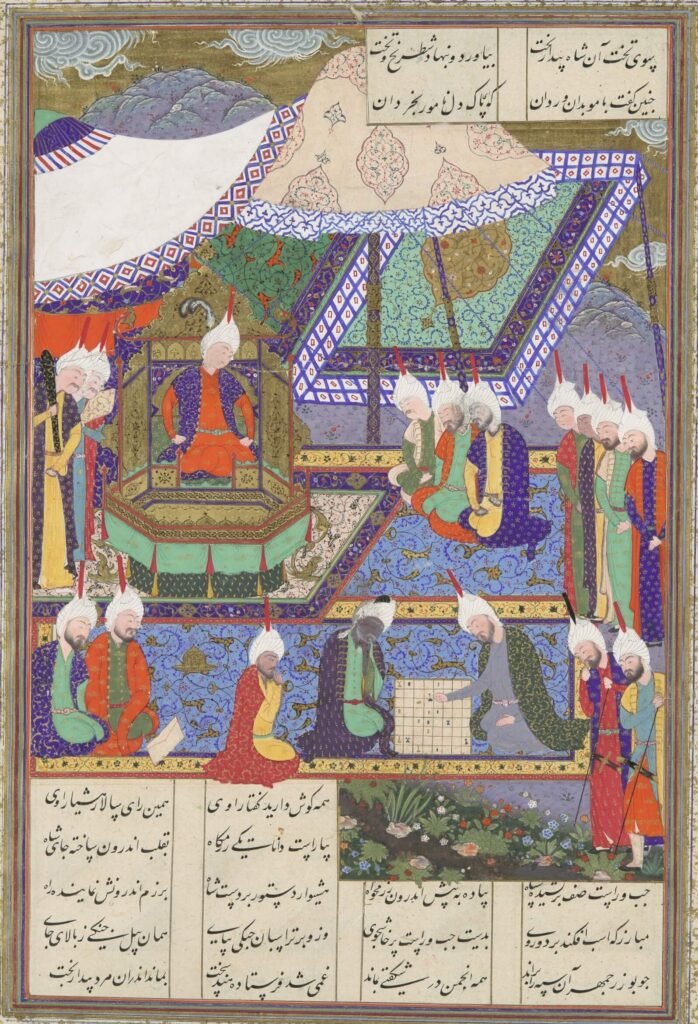
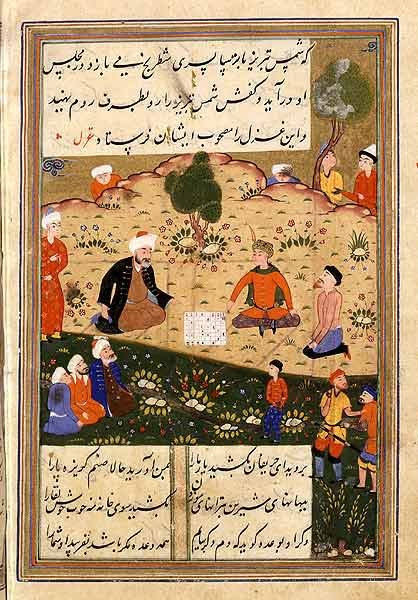
Chess Variants in Medieval Persia
As stated in the book Nafaes al-Funun written by Iranian scientist Mahmoud Amoli, seven variants of chess were popular in Iran in the middle centuries. They are:
- Old chess (or Indian chess), which is the same as today’s chess; With the difference that in Iran in the middle centuries, an elephant could move only two diagonal houses by leaping over the beads, and the minister had the right to move only one diagonal house.
- Long chess (rectangular chess / extended chess) This chess is played on a 4 x 16 board with dice and has its own rules.
- Javarehiye chess, which was played on a 7×6 board, and each section was named after one of the parts of the human body.
- Tame chess played on a 10×10 board; Amoli and Masoudi have clearly explained the rules of this chess.
- Roman chess that had a circular board and 16 pieces were arranged around a single center. Ibn Arabshah also narrated the rules of this chess.
- Chess of Dhut al-Hosun (owners of the fortress): it is played on a 10×10 board with additional squares on the edges, and there are 20 pieces on each side of the board. Dice is used in this type of chess.
- Grand chess or Timurid chess: this chess has 112 houses (on a 10 x 11 board) and there are many pieces such as the king, minister, giraffe, lion, camel, guard, dabbabe (Tank), chariot in three rows in both sides. In this chess, the pawn in front of the piece was different from the other pawn, that each pawn could be upgraded (for example, the camel pawn became a camel); The king’s pawn has become a prince if promoted (in this case, if the king was checkmated, the prince would take the throne in his place). In this chess, there are also rules for the exchange of prisoners of war. Ibn Arabshah has clearly mentioned the rules related to this chess. Some attribute the invention of this chess to Tamerlang.




Chess in Modern Iran
While chess has evolved over the centuries, its deep connection to Persia remains strong. Modern Iran has produced several world-class chess players, led by the renowned grandmaster Alireza Firouzja, who is widely regarded as one of the most talented young players in the world today. Firouzja’s rise to prominence has reignited interest in chess across Iran, inspiring a new generation of players to follow in his footsteps.
Iranian chess players are now prominent on the global stage, excelling in international competitions and further strengthening the country’s reputation in the chess world. Below is a list of 10 of the most famous and successful Iranian chess players today, showcasing the enduring strength of the game in Iran:
- Alireza Firouzja (GM) – A former prodigy representing Iran, now one of the top grandmasters globally, playing under the French flag.
- Parham Maghsoodloo (GM) – A former World Junior Champion and a key figure in modern Iranian chess.
- Sarasadat Khademalsharieh (IM, WGM) – A leading figure in women’s chess, known for her impressive achievements and activism.
- Ehsan Ghaem-Maghami (GM) – A veteran of Iranian chess with multiple national titles.
- Pouya Idani (GM) – A consistent player in international tournaments, representing the new wave of Iranian talent.
- Amin Tabatabaei (GM) – A fast-rising star who has made a name for himself with strong performances in top tournaments.
- Arash Tahbaz (IM) – An International Master with growing recognition in the chess world.
- Amirreza Pourramezanali (IM) – A young, emerging talent with notable achievements in junior tournaments.
- Morteza Mahjoob (GM) – A seasoned grandmaster with a long and successful career.
- Sina Movahed (IM) – A strong upcoming player known for his junior tournament successes and potential future growth.
These players are building on the rich legacy of chess in Persia, bringing new pride to the Iranian chess community and ensuring the game’s continued popularity in the country.
In Iran, chess is not just seen as a competitive sport but also as a cultural tradition that links the modern game to its ancient origins. The historical significance of chess in Persia is celebrated not only in tournaments but also in literature, art, and public life.
Conclusion
Chess is more than just a game in Persian culture; it is a symbol of wisdom, strategy, and the complexities of life. From its early origins in India, chess found a home in Persia, where it was embraced by the royal court and became a central part of Persian cultural life. The game’s influence can be seen in Persian literature, art, and language, and its legacy continues to thrive in modern Iran.
Whether through the legendary stories of Bozorgmehr and Khosrow Anushirvan, the poetic reflections of Omar Khayyam, or the modern-day achievements of players like Alireza Firouzja, chess remains an enduring symbol of Persia’s intellectual and cultural heritage. The history of chess in Persia is a testament to the game’s power to transcend borders, cultures, and centuries, remaining as relevant today as it was over a thousand years ago.
Reading and teaching classic Persian literature is a subtle art that shines through personalized, one-on-one classes. At Joy of Persian, we provide dedicated 1-1 sessions to help you explore and appreciate the intricate beauty of Persian literary traditions. Experience the depth of Persian culture and literature with tailored guidance from our expert instructors.


